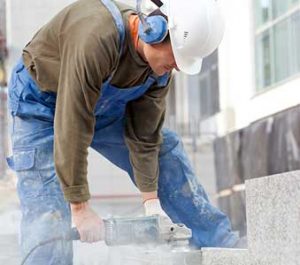OSHA’s medical surveillance requirements for employees exposed to respirable crystalline silica have been in effect since June 2018.
Soon, they’re about to get even more strict.
Effective June 23, 2020, employers will be required to assess exposures for employees who will be occupationally exposed to respirable crystalline silica, at or above the action level (AL) for 30 or more days per year.
So, how big of a deal is that?
The current permissible exposure limit (PEL) is 50 μg/m3 (measured as an 8-hour time-weighted average). In real terms, one single paver cut releases enough silica dust to hit to exceed that limit for over 10,714 days.
Now, cut that number in half, and you’ll get the AL — 25 μg/m3 — which is what OSHA will use for inspections starting in June.
What does this change mean for employers subject to general industry and maritime OSHA standards? It means more employers will now be required to make medical surveillance available at no cost, and at a reasonable time and place, to any employee whose exposure to respirable crystalline silica reaches 25 μg/m3 as an 8-hour time-weighted average for 30 or more days per year.
Related Article: How to Protect Your Team from the Effects of Silica
For those employers who are now, for the first time, required to offer medical surveillance testing, here’s a recap of the details involved in meeting these requirements:
Silica Medical Surveillance Testing Requirements
Employees must have an initial medical examination conducted by a PLHCP — an individual who is legally permitted to independently provide or be delegated the responsibility to provide some or all of the particular health care services required by the medical surveillance — within 30 days of their initial assignment.
The medical exam must be repeated every three years, or more frequently if recommended by the PLHCP.
If the PLHCP provides a written medical opinion that indicates an employee should have a specialist examination, the employer must make the exam available within 30 days after receiving that written report.
In order to comply with OSHA’s silica standard, the following testing must be conducted:
- A medical and work history, with emphasis on past, present, and anticipated exposure to respirable crystalline silica, dust, and other agents affecting the respiratory system; any history of respiratory system dysfunction, including signs and symptoms of respiratory disease (e.g., shortness of breath, cough, wheezing); history of tuberculosis; and smoking status and history;
- A physical examination with particular emphasis on the respiratory system;
- A chest X-ray (a single poster anterior radiographic projection or radiograph of the chest at full inspiration recorded on either film — no less than 14 x 17 inches and no more than 16 x 17 inches — or digital radiography systems), interpreted and classified according to the International Labor Office (ILO) International Classification of Radiographs of Pneumoconiosis by a NIOSH-certified B Reader;
- A pulmonary function test to include forced vital capacity and forced expiratory volume in one second (FEV1) and FEV1/FVC ratio, administered by a spirometry technician with a current certificate from a NIOSH-approved spirometry course;
- Testing for latent tuberculosis infection; and
- Any other tests deemed appropriate by the PLHCP.
Employer-Provided Medical and Job-Related Silica Exposure Information
In order for the PLHCP to provide a thorough medical exam, the employer must provide to the PLHCP the following information:
- a copy of the OSHA Silica standard
- a description of the employee’s previous, current, and anticipated duties as they relate to the employee’s occupational exposure to respirable crystalline silica;
- The employee’s former, current, and anticipated levels of occupational exposure to respirable crystalline silica;
- A description of any personal protective equipment used or to be used by the employee, including when and for how long the employee has used or will use that equipment; and
- Information from records of employment-related medical exams previously provided to the employee and currently within the control of the employer.
Written Medical Reports
Within 30 days of concluding an initial or periodic medical exam, the PLHCP must provide both the employer and the employee with copies of the results of their medical examination.
If you would like more details on the required content of these reports, please contact us, just complete the form below.
On-Site Silica Physical Exams
You’ll need to find a medical provider in your area that specializes in occupational health.
In the case of Worksite Medical, if you’re in the eastern portion of the United States, we will bring the clinic right to your job site!
We offer mobile medical testing, such as silica physical exams, respirator fit tests, blood work, and audiometric exams. And, we do it all on your terms, at your convenience.
To schedule or to get your free quote, just complete the form below.
You can also start a live chat on the right of your screen, or call us at 1-844-622-8633.
***
About Worksite Medical
In most cases, OSHA requires medical surveillance testing, and at no cost to employees.
Worksite Medical makes that program easier with mobile medical testing.
We conduct on-site respirator fit tests, as well as pulmonary function test and heavy metal lab work, right on your job site. We also keep accurate, easy-to-access medical records for your convenience. You’ll keep your employees at work, and stay ahead of OSHA inspections.
With Worksite Medical, a mobile medical testing unit — we can bring all the resources of a lab to you. Our certified lab technicians can perform both qualitative and quantitative respirator tests to ensure a perfect fit.
Protect your team and your workplace now with Worksite Medical. Not sure what you need? Try our medical testing wizard here.
Give us a call at 1-844-622-8633, or complete the form below to schedule an on-site visit or to get your free quote!




